|
The concept of collectivism arises from the social theory that defends that the interest and the well-being of the group are more important than the interest and well-being of each individual in particular. In order to educate the children in this feature of their personality. so important in education for peace, there are diverse routes, one of the most important is collective work that makes it possible to develop responsibility and collectivistic feelings. An important aspect in these activities is the planning of the tasks and the coordination of actions on the part of the children. For this, opinions will be requested about what they are going to do, how they are going to do it, so that they distribute the tasks and everybody is occupied and they share in it. A way to organize work consists of having everybody do the same activity with a common aim, for example, to elaborate a greeting card to give to their classmates on the day of their birthdays. Another more complex variant to organize the collective work can be, for example, before the coming of a birthday, to invite the children to think what we could make to decorate the classroom. The children must participate with diverse proposals as far as cleaning, and decorating. When finalizing it is important that the children value the results of the work done and emphasize the work of each one in this achievement, since all have to take part in the proposed task, so that they later experience the joy of having fulfilled what they set out as a common effort. |
ACTIVITY
No 1 |
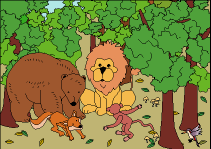 |
Summary of the activity: The educator will narrate the story "A meeting in the forest", he will analyze the story with the children, later a collective task will be suggested that will culminate with a collective party in the class for the children who celebrate their birthday in the month. Objectives: That the children feel satisfaction in working for the group. Procedures:
Material Resources: Cardboard, coloured paper, watercolours, temperas, glue, stickers.
Development of the activity:
2nd
Part As a summary of the conversation they will talk about the selfish attitude of the woodpecker and the bear, and the collectivistic attitude of the lion, the beaver, the fox and the monkey will be praised. They will clarify the words of the lion when he said that there is strength in union.
3rd Part The educator will leave the children to express freely. Later he says to them that as they already know that there is strength in union, then, they are going to unite all their efforts with the purpose of decorating the classroom for the celebration of the collective birthdays, and he will name the children who celebrate in that month. A collective work is organized. A group will take care of the organization and the cleaning of the room. Another group has to take care of the preparation of the decorations, such as garlands, paper chains, drawings for the walls, etc. A third group will make: caps, invitations for the party, markers, drawings and cards for the honoured children. Once they finalized, there will be an evaluation of the work done, and the results that they have obtained collectively. 4th
Part |
CRITERIAL
ASSESSMENT |
|||
Observed
conduct |
YES |
NO |
Comments |
In
the answers to the questions it is observed that they understood the
message of the story. |
|||
They
needed help to understand the message of the story. |
|||
They
had expressions of satisfaction for the work done. |
|||
They
did the assigned task well in the collective work. |
|||
They
needed help to take the assigned task to the end. |
|||
ACTIVITY
No 2 |
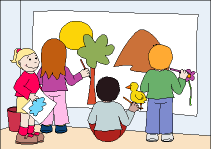 |
Summary of the activity: The activity is a painting workshop, where the children will make a poster or a mural to decorate the class. In the first part of the activity the educator proposes to make the poster or mural, and individual drawings for those children who do not participate in the great drawing. He will explain the objective of these drawings and how they are going to do it. In the second part the children draw and the third part will consist of the inauguration of the mural and the exhibition of the selected individual works. Objectives: That the children manage to coordinate their actions to paint as a group a painted mural Procedures:
Material Resources: Paper, pencils, temperas, watercolours, tape, and other materials of plastic arts.
Development of the activity: They will draw about the theme: "The birthday of my friends". The young painters must reach an agreement on what each one will paint and in which part of the paper they will do it. The children who do not want to paint in the mural will do it in individual papers that will also be exposed (those that are selected). The educator puts on the floor, or stuck with tape on the wall at the height of the hands of the children a great piece of paper. It is important that everybody knows that the objective of this painting is to decorate the classroom for the celebration of the collective birthday.
2nd Part The children will evaluate and select the best works that were done individually.
3rd Part |
CRITERIAL
ASSESSMENT |
|||
Observed
conduct |
YES |
NO |
Comments |
They
knew how to coordinate well their actions. |
|||
They
needed help to coordinate their actions. |
|||
They
felt satisfaction and pride for the work done. |
|||
They
were organized in groups to carry out the tasks. |
|||
They
spoke about the group work. |
|||
ACTIVITY
No 3 |
 |
Summary of the activity: This activity is a mini camp. All the children will work organizing it, for this the tasks will have to be distributed so that everyone must contribute with something. They will prepare all the necessary things: several tents, the food, etc. Once they are camped, activities of singing and dancing will be organized. The camp can be in the garden of the school or in a nearby place where the educator designates, and that is easy to reach and with no risk for the children. Objectives:
Procedures: Material Resources: Tents for the camp, torches, lights, food supplies, hammocks, canvas sacks, broom, water containers, first-aid kit with medicines, radios, cassette recorder, camera etc.
Development of the activity: Tasks for the organization of the camp will be distributed, so that all the children have something to do.
2nd Part During the camp the children will sing, dance, recite, tell stories, play games, etc.
3rd Part The activity will finalize with an evaluation by the children of the work of each one to achieve the success of a fun camp. |
CRITERIAL
ASSESSMENT |
|||
Observed
conduct |
YES |
NO |
Comments |
They
knew how to coordinate the tasks for the activity. |
|||
They
needed help to coordinate the tasks for the activity. |
|||
They
fulfilled with satisfaction the assigned task. They enjoyed the camp. |
|||
They
helped each other in the accomplishment of the tasks of the camp. |
|||
ACTIVITY
No 4 |
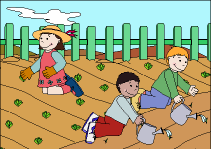 |
Summary of the activity: It is about the children seeding, watering and cleaning the weed in the vegetable garden, so that later they gather the harvest and all eat the vegetables that they planted; they will also recite verses about the vegetable garden. Objectives: To have the children coordinate their actions with the purpose of obtaining a useful result for the entire group. Procedures:
Material Resources: Tools to work in the vegetable garden: rake, watering cans, etc.
Development of the activity: He will let the children participate and later he will teach some verses to them, with the intention that they repeat them during the collective activity in the vegetable garden.
2nd Part The children will recite the verses they learned, later they will water and clean the vegetables of the garden. He will let them know that in the future when the harvest is ready, like the peasants do, they will gather it. In order to be able to be gathered quickly seasonal vegetables and of a short cycle will be used. 3rd
Part To pick those vegetables that can already be eaten. The educator will prepare with the help of the cook or of a mother, a rich vegetable plate so that the children taste them. The educator summarizes the activity emphasizing that what they are eating is product of the work of all. |
CRITERIAL
ASSESSMENT |
|||
Observed
conduct |
YES |
NO |
Comments |
They
organized well the work in the vegetable garden in an independent
way. |
|||
They
needed help to organize the work. |
|||
They
worked well in the vegetable garden until the end. |
|||
They
felt joy and satisfaction with the work done. |
|||
They
recited with enthusiasm the poem. |
|||
They helped each other during the activity. |
|||
ACTIVITY
No 5 |
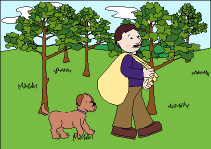 |
Summary of the activity: Narration of the story "A house for everybody". Conversation about the story. Finally, constructions will be made so that the little animals can live in them. Objectives: To stimulate the development of collectivistic feelings in the children. Procedures:
Material Resources: Pictures, builders’ games, a group of little animals toys.
Development of the activity:
2nd Part How
do you help your family at home? 3rd
Part The educator will invite the children to construct together a great house or a great building with its fences and bridges. They can also make caves so that the little animals can live. The children will be given a group of little animals so that they have an idea of the size of the house or cave that they must construct so that everybody fits. They will agree on the part that each one will construct and the place where they are going to do it. When they have finalized they will evaluate the work done and the educator will summarize the activity. It is important that he emphasizes how, coordinating the operations to work as a group, they have obtained a pretty result that will be very useful for the little animals. |
CRITERIAL
ASSESSMENT |
|||
Observed
conduct |
YES |
NO |
Comments |
They
coordinated well their actions. |
|||
They
needed help to coordinate the work. |
|||
They
made pretty constructions and they worked in an independent way. |
|||
They
needed help to obtain an end result. |
|||
They
felt satisfaction for the work done. |
|||
ACTIVITY
No 6 |
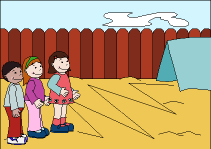
|
Summary of the activity: This is a game of movement called: "Everybody’s house". A tent and a zigzag line painted on the floor will be prepared in the outside area that the children must cross to arrive at everybody’s house. Objectives: To have the children coordinate their actions and movements for the achievement of a common aim. Procedures: Game Material Resources: Little flags of two colours: red for a team and blue for the other, coloured chalks to draw the lines on the floor, a tent.
Development of the activity: Organization: Two teams will be formed: the red and the blue one, both with the same number of children. Each team forms a row, in front of each row, and with a distance of four or five meters, there is a zigzag line drawn on the floor on which the children must run in order to arrive at a tent that is "A house for everybody" where there will be baskets with red and blue little flags, one basket for each team. The
rules of the game are:
2nd Part When told, the first child of each row will leave running on the drawn lines. When arriving at the end and entering everybody’s house, he will take a flag of the colour of his team and he will signal it to his classmate who will leave running, and like that until the row is finished.
3rd Part After the new game is played, the educator will tell the children that he congratulates them for the effort made, he will give greeting cards, markers, pencils, watercolours, story books to the winners and a congratulation for all the children who worked positively for their team, that this is how they must always work, looking for the collective good of all. |
CRITERIAL
ASSESSMENT |
|||
Observed
conduct |
YES |
NO |
Comments |
They
coordinated well their actions and movements in an independent way. |
|||
They
needed help to coordinate their actions and movements. |
|||
They
felt satisfaction for the activity done. |
|||
They
made an effort so that their team won. |
|||
Before
the critical dilemma they chose to mix themselves and to make new
teams. |
|||
They enjoyed altogether for the collective effort made. |
|||


